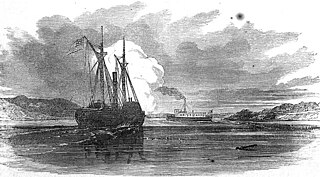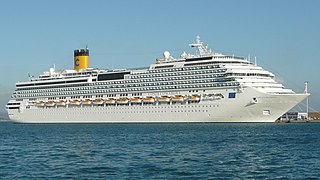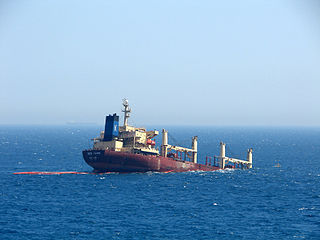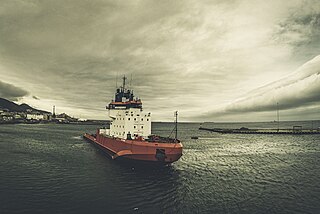
A tugboat or tug is a marine vessel that manoeuvres other vessels by pushing or pulling them, with direct contact or a tow line. These boats typically tug ships in circumstances where they cannot or should not move under their own power, such as in crowded harbour or narrow canals, or cannot move at all, such as barges, disabled ships, log rafts, or oil platforms. Some are ocean-going, some are icebreakers or salvage tugs. Early models were powered by steam engines, long ago superseded by diesel engines. Many have deluge gun water jets, which help in firefighting, especially in harbours.

A salvage tug, known also historically as a wrecking tug, is a specialized type of tugboat that is used to rescue ships that are in distress or in danger of sinking, or to salvage ships that have already sunk or run aground.
SS Atlantic Empress was a Greek oil tanker that in 1979 collided with the oil tanker Aegean Captain in the Caribbean, and eventually sank, having created the fifth largest oil spill on record and the largest ship-based spill having spilled 287,000 metric tonnes of crude oil into the Caribbean Sea. It was built at the Odense Staalskibsværft shipyard in Odense, Denmark, and launched on 16 February 1974.

Marine salvage is the process of recovering a ship and its cargo after a shipwreck or other maritime casualty. Salvage may encompass towing, re-floating a vessel, or effecting repairs to a ship. Today, protecting the coastal environment from spillage of oil or other contaminants is a high priority. Before the invention of radio, salvage services would be given to a stricken vessel by any ship that happened to be passing by. Nowadays, most salvage is carried out by specialist salvage firms with dedicated crew and equipment.

Alkimos was a Greek-owned merchant ship which was wrecked on the coast north of Perth, Western Australia in 1963. A nearby locality was later named after the vessel. The wreck is a popular diving venue.

Costa Concordia was a cruise ship operated by Costa Crociere. She was the first of her class, followed by sister ships Costa Serena, Costa Pacifica, Costa Favolosa and Costa Fascinosa, and Carnival Splendor built for Carnival Cruise Line. When the 114,137-ton Costa Concordia and her sister ships entered service, they were among the largest ships built in Italy until the construction of the 130,000 GT Dream-class cruise ships.

MV Anthea, previously known as MV Drake, previously known as Pasha Bulker, is a Panamax bulk carrier of 76,741 tonnes deadweight (DWT) operated by the Lauritzen Bulkers shipping company and owned by Japanese Disponent Owners. While waiting in the open ocean outside the harbour to load coal, Pasha Bulker ran aground during a major storm on 8 June 2007 on Nobbys Beach in Newcastle, New South Wales, Australia. It was refloated and moved to a safe location offshore on 2 July 2007 at 9:48 p.m. AEST before being towed to Japan for major repairs on 26 July 2007.

MV New Flame was a Panamanian bulk-carrier cargo ship. It collided with an oil tanker off Europa Point, the southernmost tip of Gibraltar on 12 August 2007, and ended up partially submerged in the Strait of Gibraltar. The vessel broke into two in December 2007 amid numerous unsuccessful recovery efforts. The cargo was salvaged and the stern section removed for scrap. Following the crew's rescue, the captain was arrested for having departed without authorisation. Charges of endangering shipping were later dropped.

An emergency tow vessel, also called emergency towing vessel, (ETV) is a multi purpose boat used by state authorities to tow disabled vessels on high seas in order to prevent dangers to man and environment. The disabled vessel is either towed to a safe haven or kept in place against wind and current until commercial assistance by tug boats has arrived on site or until it has been repaired to the extent of being able to manoeuvre on its own. The need for ETVs as a preventive measure has arisen since the number of available commercial salvage tugs was reduced while potential dangers from individual vessels have increased. E.g. Spain has fourteen, Turkey has eleven, Germany operates eight, Norway has seven, France has five, Sweden three and the Netherlands, Poland, South Africa, Iceland and Finland each have one official emergency tug boat. Australia also operates emergency response vessels. The United Kingdom's four strong ETV fleet was to be disbanded in September 2011 due to budget cuts but the two vessels operating in Scottish waters received an extension of contract until the end of 2011.
Salvage Code Red is a National Geographic Channel TV series that charts the work of rival groups of marine salvage experts.

The MV Seli 1 was a Turkish bulk carrier, operated by TEB Maritime of Istanbul, that was en route to Gibraltar when it was driven aground off Bloubergstrand near Table Bay, South Africa by strong westerly winds shortly after midnight on 8 September 2009, having reported engine failure and a snapped anchor chain.

Nyon was a 5,364 GRT cargo ship that was built in 1952. She ran aground in 1958, and was cut in two in order to salvage her. The stern section was salvaged and a new bow section built and fitted in 1959. She served until 1962 when she was involved in a collision with another ship and sank.

The United Kingdom's emergency towing vessel fleet were a maintained fleet of emergency tow vessels (ETV) from 1993 through 2011. The vessels were privately owned and operated for Her Majesty's Coastguard. Four vessels were stationed around the UK coastline, while a fifth was held in reserve.
The SS Wafra oil spill occurred on 27 February 1971, when SS Wafra, an oil tanker, ran aground while under tow near Cape Agulhas, South Africa. Approximately 200,000 barrels of crude oil were leaked into the ocean. The larger part of the ship was refloated, towed out to sea, and then sunk by the South African Air Force to prevent further oil contamination of the coastline.

MSC Flaminia is a German container ship which caught fire on 14 July 2012, claiming three lives and forcing the crew to abandon ship in the middle of the Atlantic Ocean. After the fire had been brought under control, the stricken container ship was towed to Europe and arrived at Wilhelmshaven, Germany, on 9 September 2012. In March 2013, she departed Wilhelmshaven for Mangalia, Romania for repairs which were finished in July 2014. The ship is currently sailing under the name CMA CGM San Francisco.

Kigoriak is a Russian icebreaking anchor handling tug supply vessel. Built by Saint John Shipbuilding & Dry Dock Company for Canadian Marine Drilling (Canmar) in 1979 as Canmar Kigoriak, she was the first commercial icebreaking vessel developed to support offshore oil exploration in the Beaufort Sea.












